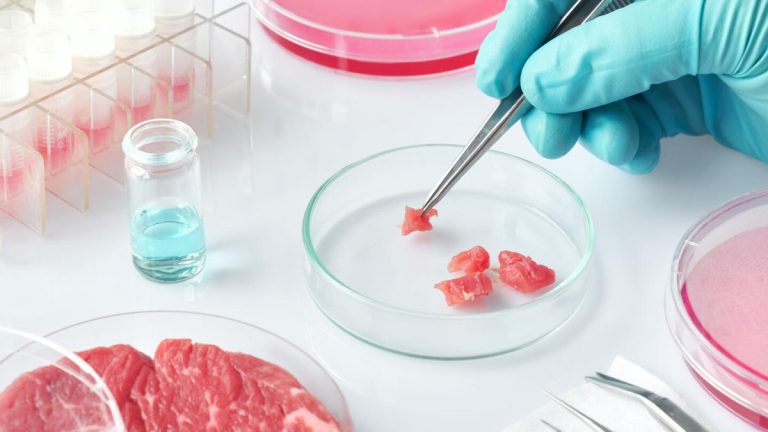Fructose is found in fruits and vegetables, but it’s not always healthy for you. Fructose intolerance can lead to unpleasant symptoms. How can you treat these?
Do you like to eat fruit and vegetables and drink fruit juices? But do you often suffer from flatulence, abdominal pain, nausea or diarrhea afterwards? Then a so-called fructose intolerance or fructose intolerance could be the reason. Even if you don’t see it at first glance in the products, most foods contain more sugar than we would like. Fructose is found in numerous foods and at first glance an intolerance is not so easy to identify. Fructose intolerance is now affecting more and more people, with almost 40 percent of the western population now suffering from it.

What is fructose anyway?
Fruit sugar, also known as fructose/fructose, is found in numerous foods. It usually gives them their sweetness and is mainly found in fruit, fruit juices, jam, honey, some syrups and numerous finished products, but fructose is also found in table sugar, lemonade and sweets. It is absorbed in the small intestine via transport proteins and then reaches the liver via the bloodstream. Fructose provides no directly available energy and has no effect on insulin levels. However, our body is not at all dependent on fructose in terms of nutrition, which is why the human metabolism is overwhelmed by large quantities, only 25 to 50 grams can be used without any problems. The excess amount is always directed into the large intestine and can cause flatulence and abdominal pain there, even in healthy people. Fructose comes in different forms. Once in free form as a simple sugar (monosaccharide) in food, i.e. in fruit, vegetables, fruit juices and honey. Here it consists of a single sugar molecule. The simple sugars also include glucose, fructose and mucilage, but monosaccharides are also found in industrially manufactured drinks, sweets and finished products.
There is also fructose as a double sugar (disaccaride), with fructose together with glucose forming the usual household sugar, which is used very frequently and is contained in numerous foods and drinks. Disaccarides consist of two simple sugar molecules, including lactose, cane and beet sugar or malt sugar (maltose). This occurs when grain germinates and is contained in pasta, potatoes and beer, among other things.
Fructose also occurs as multiple sugars (polysaccharides). This consists of many fructose molecules firmly connected to one another, at least ten simple sugar molecules, such as inulin or the levan type, which is also found in small amounts in local vegetables such as asparagus, leeks, garlic or onions. Polysaccharides also include starch, dextrins, glycogen or roughage.
What is fructose intolerance?
There is talk of a food intolerance when, for example, fructose is simply not well tolerated. On the other hand, one speaks of an intolerance when the body cannot break down a certain substance properly because it lacks the necessary enzyme. Fructose intolerance is more widespread than intolerance. The intestines can only absorb limited amounts of fructose, but can metabolize it normally, and an enzyme deficiency can also play a role here. A disease is present when the body cannot process unusually small amounts (less than 25 grams) of fructose in the small intestine or when no fructose can be metabolized at all. Doctors also speak of a “hereditary fructose intolerance”.
In the mucous membrane of the small intestine there are small transport proteins (so-called GLUT) through which the nutrients from the interior of the intestine get into the blood. Fructose is also transported in this way, but the transport proteins can only absorb a limited amount of fructose. How much the body can ultimately transport is very individual. If the transport limit is reached, fructose enters the large intestine undigested. The bacteria that live there use them as energy suppliers and break down the sugar. This produces gases and short-chain fatty acids, which can trigger typical symptoms such as abdominal pain, flatulence or diarrhea. Some of the gases are also absorbed into the blood and exhaled through the lungs. A so-called breath test can measure the increase in the concentration of the gas in the breath and thus provide a possible diagnosis of fructose intolerance.
Another cause of fructose intolerance, in addition to a transport limit of the GLUTs, can also be too fast digestion, i.e. the chyme passes through the small intestine too quickly. There may also be too few transport proteins present or they may only be able to perform to a limited extent by nature. Gastrointestinal infections or even a chronic inflammatory bowel disease that attacks the intestinal wall, such as Crohn’s disease, can also trigger intolerance to fructose. Fructose intolerance is not curable, but by changing your diet, those affected can lead a largely symptom-free life.
Symptoms of fructose intolerance
In addition to abdominal pain, flatulence and diarrhea, other symptoms can occur that indicate fructose intolerance. However, a doctor should be consulted for final clarification. First, the symptoms of fructose intolerance depend on whether the condition is congenital or acquired. As already mentioned, congenital and inherited fructose intolerance is also called hereditary fructose intolerance and is rather rare. This type of intolerance is caused by a genetic enzyme defect that leads to an intolerance to foods containing fructose and sucrose. If left untreated, this defect can initially lead to hypoglycaemia, later to liver, eye and kidney damage. The hereditary fructose intolerance shows up early on, because the smallest traces of fructose are found in breast milk or in the follow-on milk powder. In addition to nausea and vomiting, headaches and concentration problems often occur, coagulation disorders and hypoglycaemia are further consequences of the innate intolerance. Feeling weak, sweating, dizziness, or seizures and fainting are also symptoms. Fructose should definitely be avoided here. Early detection of the chronic disease in combination with a fructose-free diet can alleviate the course.
There is also the so-called fructose malabsorption, the acquired fructose intolerance. This is a disorder of the glucose transporter GLUT 5, which disrupts the absorption of fructose in the small intestine and causes the sugar to reach the large intestine, where it is broken down by bacteria. A feeling of fullness, bloating and abdominal pain, especially in the lower abdomen, which escalate to cramps, can be the first signs of fructose malabsorption. In addition to audible stomach noises and nausea, diarrhea and/or a changed, mushy or slimy stool can also indicate an intolerance. Constipation, heartburn, acid regurgitation or even extreme tiredness, especially after eating, can also indicate an intolerance. A nutrient deficiency can also be a consequence of acquired fructose intolerance, since zinc or folic acid, for example, cannot be properly absorbed. This can lead to other symptoms such as hair loss, anemia or headaches. In addition to fructose intolerance, milk sugar intolerance (lactose intolerance) often develops. Furthermore, a fructose intolerance can probably even affect the psyche, here scientists suspect that the deficiency cannot produce enough serotonin, which can contribute to the development of depression, among other things.
In general, it can be said that the symptoms of fructose intolerance mainly occur when large amounts of fructose have been consumed. When exactly the symptoms appear and how long they last varies from person to person. They are usually intensified by an unfavorable composition of food, for example if the food contains a lot of fructose but little protein and fat. In general, it can be recommended to consume fructose together with glucose and to ensure a sensible intake, but here too there are no specific limit values for the intake of fructose in the event of fructose malabsorption.
What you can do about fructose intolerance
If you think you might have fructose intolerance, you should first consult your family doctor. They can carry out initial tests or refer you to specialists. There are several ways to diagnose fructose intolerance.
First, the medical history and the type of symptoms, their intensity and duration are queried. Another aspect is asking about nutrition and the daily menu. A physical examination is then carried out, the abdomen is palpated and listened to in order to be able to exclude unusual noises. This is often followed by a blood test and a fructose intolerance test, also known as the H2 breath test. The hydrogen breath test can be used to check whether the consumed fructose has reached the large intestine. Hydrogen is produced when the fructose is broken down by the bacteria in the large intestine. These tiny molecules then enter the blood and are exhaled through the lungs, which is why the hydrogen content in the breath can be determined. First, the doctor measures the basal value (initial value) for the hydrogen in the breathing air. To do this, you have to blow hard into a measuring device. A glass of water containing 25 grams of dissolved fructose is then drunk. Over the next two hours, the doctor measures the hydrogen content in the breath at regular intervals and records the values and symptoms. If the value rises to more than 20 ppm above the initial value once or twice in a row, this indicates a fructose intolerance. However, there is an exception here, as some people do not emit any hydrogen at all. In these people, the bacteria in the large intestine do not produce hydrogen when they break down sugar and the hydrogen breath test is negative, even though they are fructose intolerant. For clear clarification of this there is the so-called methane test, which measures methane in the breathing air, since in some people the intestinal bacteria do not convert fructose into hydrogen but into methane gas.
In order to get the most meaningful test result possible, you should not eat flatulent or sweet foods 24 hours before the test and only drink water, do not smoke, do not chew gum and do not exercise 12 hours before the test. The tests usually take place in the early morning. There are now also fructose intolerance tests that you can take at home, but you should note that these are hardly meaningful and the test samples usually cannot be stored properly.

Conclusion
Even if fructose intolerance is more common than you think, you should generally pay attention to a conscious and healthy diet. Fructose is not only contained in many finished products, the rather unhealthy compounds are often also found in diabetic or light products, where fructose is often used as a sweetener, which is why special attention should be paid here.
Even if a fructose intolerance is not behind every feeling of fullness or bloating, a doctor should be consulted quickly if symptoms are frequent and intense, because if a fructose intolerance is noticed too late, it can have far-reaching consequences. Since the intensity of the symptoms is different for everyone, not every patient with fructose intolerance develops all symptoms. A permanent diet free of fruit or fructose is only recommended in the case of hereditary fructose intolerance. In the case of an acquired fructose intolerance, those affected are advised to avoid fructose for a while. After a phase of fructose and sorbitol-free food, you can start again with small amounts to find out whether and which food is tolerated without symptoms. There are now numerous lists of foods and products that contain fructose and fructans.
About 20 percent of people with fructose intolerance also have lactose intolerance. It is important to pay close attention to this, because the typical symptoms of both diseases can be similar and should be clarified by a doctor. Nutritional advice is often useful here, where an individual menu can be worked out together with the patient. Often a minimal change can bring a big success. When shopping, the list of ingredients should always be checked, as even the smallest amounts of sugar substitutes can promote intolerance. There are also over-the-counter products for people* with an acquired fructose intolerance, which convert fructose into more easily digestible components and can have a supportive effect even with a slight intolerance.












